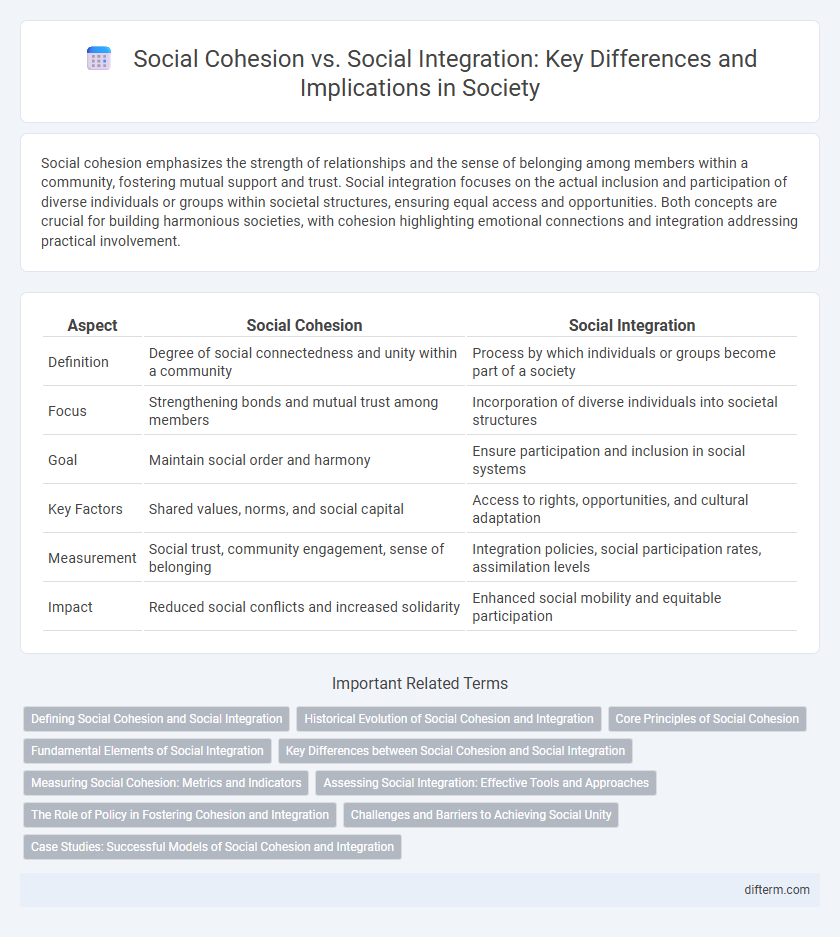Social cohesion emphasizes the strength of relationships and the sense of belonging among members within a community, fostering mutual support and trust. Social integration focuses on the actual inclusion and participation of diverse individuals or groups within societal structures, ensuring equal access and opportunities. Both concepts are crucial for building harmonious societies, with cohesion highlighting emotional connections and integration addressing practical involvement.
Table of Comparison
| Aspect | Social Cohesion | Social Integration |
|---|---|---|
| Definition | Degree of social connectedness and unity within a community | Process by which individuals or groups become part of a society |
| Focus | Strengthening bonds and mutual trust among members | Incorporation of diverse individuals into societal structures |
| Goal | Maintain social order and harmony | Ensure participation and inclusion in social systems |
| Key Factors | Shared values, norms, and social capital | Access to rights, opportunities, and cultural adaptation |
| Measurement | Social trust, community engagement, sense of belonging | Integration policies, social participation rates, assimilation levels |
| Impact | Reduced social conflicts and increased solidarity | Enhanced social mobility and equitable participation |
Defining Social Cohesion and Social Integration
Social cohesion refers to the strength of relationships and the sense of solidarity among members of a community, emphasizing shared values, trust, and collective well-being. Social integration involves the process by which individuals or groups from diverse backgrounds become incorporated into the social structure, gaining access to institutions, participation, and social networks. While social cohesion highlights unity and mutual support, social integration focuses on inclusion and equal participation within society.
Historical Evolution of Social Cohesion and Integration
Historical evolution of social cohesion reveals its roots in collective identity and shared norms within early human societies, emphasizing mutual trust and cooperation. Social integration evolved as a process accommodating cultural diversity and institutional frameworks, enabling individuals from varied backgrounds to participate fully in social, economic, and political life. Key milestones include the transition from homogeneous tribal groups to complex multicultural states, highlighting shifts in policies and societal values promoting inclusion and unity.
Core Principles of Social Cohesion
Social cohesion emphasizes shared values, trust, and a sense of belonging among community members, fostering mutual support and inclusiveness. Core principles include social inclusion, equity, and participation, which ensure that all individuals feel valued and connected. These elements strengthen collective identity and promote stability within diverse societies.
Fundamental Elements of Social Integration
The fundamental elements of social integration include shared values, mutual respect, and active participation within diverse social groups, which foster a sense of belonging and unity. Social cohesion emphasizes harmony and trust among community members, while social integration focuses on the practical inclusion and interaction of individuals across different social backgrounds. Effective social integration requires accessible institutions, equal opportunities, and inclusive policies that facilitate connections and reduce social disparities.
Key Differences between Social Cohesion and Social Integration
Social cohesion emphasizes the strength of relationships and sense of solidarity among community members, fostering trust and mutual support. Social integration focuses on the process by which individuals from diverse backgrounds become fully participating members of society through inclusion in social, economic, and political systems. Key differences lie in social cohesion highlighting collective belonging and shared values, while social integration centers on the incorporation and acceptance of individuals or groups within the broader social structure.
Measuring Social Cohesion: Metrics and Indicators
Measuring social cohesion involves analyzing metrics such as trust levels, social networks, and participation in communal activities to capture the strength of social bonds within a community. Social integration metrics focus on indicators like inclusion rates, access to resources, and representation of diverse groups in social institutions. Reliable data collection on these indicators enables policymakers to assess social stability and design interventions that enhance both cohesion and integration effectively.
Assessing Social Integration: Effective Tools and Approaches
Assessing social integration requires tools that measure individuals' participation in community activities, sense of belonging, and access to social networks. Surveys, social network analysis, and ethnographic studies provide comprehensive data on the quality and extent of integration within diverse populations. Effective approaches combine quantitative metrics with qualitative insights to capture both structural inclusion and emotional connectedness.
The Role of Policy in Fostering Cohesion and Integration
Effective policy plays a critical role in fostering social cohesion and integration by promoting inclusive frameworks that encourage shared values and equitable opportunities. Targeted initiatives such as community engagement programs, anti-discrimination laws, and accessible social services help bridge social divides and enhance mutual trust among diverse populations. Policymakers must prioritize both structural inclusion and cultural recognition to achieve sustainable and harmonious social environments.
Challenges and Barriers to Achieving Social Unity
Social cohesion faces challenges such as economic disparities, cultural differences, and institutional discrimination that hinder collective identity and trust among community members. Social integration barriers include language obstacles, unequal access to resources, and social exclusion, which prevent marginalized groups from fully participating in society. Overcoming these challenges requires targeted policies promoting inclusivity, equal opportunities, and intercultural dialogue to enhance social unity.
Case Studies: Successful Models of Social Cohesion and Integration
Case studies of social cohesion and integration highlight models such as the Scandinavian welfare states, where inclusive policies promote equal access to education, healthcare, and employment, fostering social trust and reducing inequality. Another successful example is Canada's multiculturalism framework, which emphasizes cultural recognition and active participation of diverse communities, leading to enhanced civic engagement and reduced social fragmentation. Research from urban intercultural projects in Amsterdam illustrates that community-driven initiatives encouraging dialogue and collaboration directly contribute to stronger social bonds and collective identity.
social cohesion vs social integration Infographic

 difterm.com
difterm.com